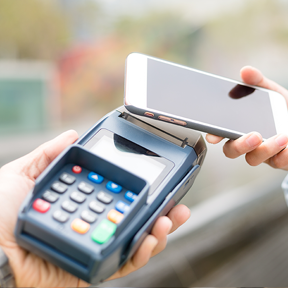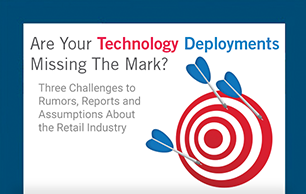Retailers are deploying a great number of technologies to streamline the point of sale in their stores in an effort to reduce wait times, speed the payment process, and improve the customer experience. The Gartner RIS 27thAnnual Retail Technology Study reports that, on average, retailers plan to increase their IT budget by 3.5% year-over-year, an indication that investments in technology are considered essential. While not an exhaustive list, below are some of the critical component technologies that retailers are investing in to move toward frictionless checkout.
IoT – IoT is being used for a variety of purposes, from item-level inventory tracking to customer shopping pattern insight as they interact with different items in the store, to identification of specific goods added to shopping carts in the store. IoT is a major investment, which was partially responsible for stalling out adoption when RFID was first introduced in retail in the early 2000s. However, with the explosion of artificial intelligence, big data and machine learning, the data collected by IoT devices can now be easily aggregated and analyzed to deliver information for a variety of purposes. For example, IoT can now be used to collect consumer shopping patterns while in store: where they go, what they look at. That information, in turn, can be used to direct them to items of interest in the store, items on sale, etc. In the future, IoT devices will even tell them what they have at home. Is there an extra bottle of milk in the fridge or do they need to pick up one up while in store?
Beacon technology– Consumers expect retailers to deliver value-added content to their mobile devices as they shop in the store. Whether coupons, useful information or personalized offers, retailers are delivering a more personalized, value-added customer experience by instantly identifying shoppers’ mobile devices when they enter the store and using it as a channel to connect with them and deliver the omnichannel shopping experience. Beacon technology also streamlines the checkout process by identifying the customer and allowing them to use mobile apps to quickly pay or simply walk out of the store and be charged for goods in their shopping carts.
Video/Cameras– Cameras are essential for traditional loss prevention purposes as well as highly sophisticated networks of systems that leverage video analytics to determine which product and how many the customer has selected and put into their cart. Cameras must be placed in volume in highly-automated stores to correctly discern products. Like IoT devices, cameras provide a unique form of data that can unearth valuable information like shopping traffic patterns, product-level interaction, effectiveness of end caps and specific promotions.
Near Field Communication (NFC)
 NFC is the short-range wireless radio transmission technology enabling “tap and go” payments with credit cards and mobile devices. Not as widely adopted in the U.S. as across other international market s, contactless payment is on the rise and retailers will be adopting devices with NFC to speed the payment process.
NFC is the short-range wireless radio transmission technology enabling “tap and go” payments with credit cards and mobile devices. Not as widely adopted in the U.S. as across other international market s, contactless payment is on the rise and retailers will be adopting devices with NFC to speed the payment process.
Mobile POS- Mobile POS hardware and software technologies are used on common mobile devices including tablets and mobile phones to shift from cashiers at POS machines to employees seamlessly completing transactions for customers. According to a recent survey by Boston Retail Partners, 84 percent of the surveyed retailers plan to deploy mobile POS solutions within the next three years. Cloud-based POS systems can ensure consistency across multiple store locations easily and can also report detailed sales information by store, item or other criteria.
These are just a few of the many technologies that come together to create a streamlined checkout experience. Retailers must carefully configure their specific point of sale goals and then prioritize technology investments accordingly. In the next post, we’ll evaluate how streamlined checkout delights customers and the other benefits that retailers are seeing from the transformation of the point of sale.




